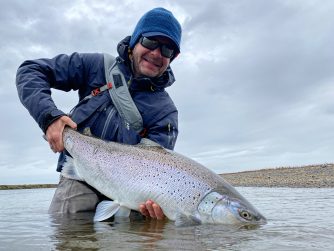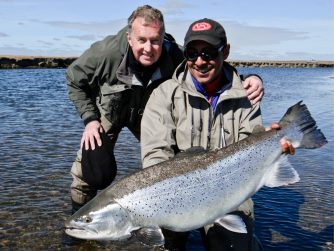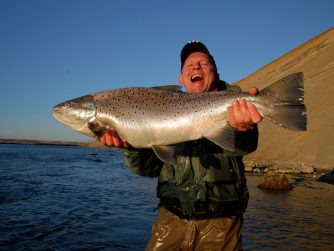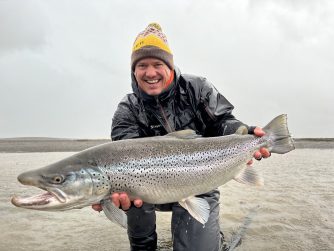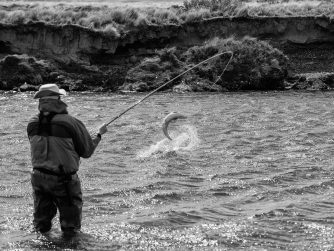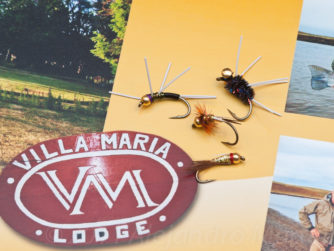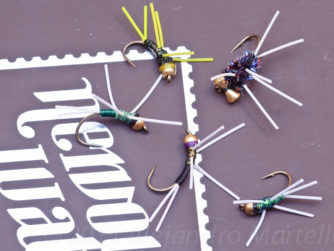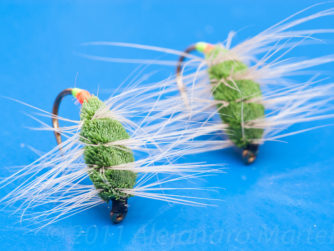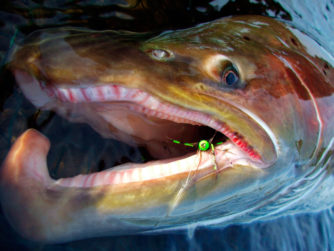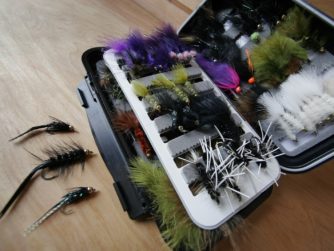Fishing the Rio Grande
In 1935, Englishman John Goodall planted the first brown trout in Tierra del Fuego. Imported from Puerto Montt, Chile, 60,000 salmo trutta eggs were dropped in two tributaries of the Rio Grande. These industrious trout have since found their way to the sea, where they grow large and strong before returning to the Rio Grande to propagate the next generations.
Sea-run browns spawn during fall in the Southern Hemisphere (late March, April, and May). Juveniles typically spend one to four years in fresh water before their first migration to sea. In the ocean they feed and grow for approximately six months before returning to the river—weighing about three to six pounds. Trout, unlike salmon, will spawn and return to the ocean multiple times through the course of a lifetime. Researchers have reported sea-run specimens that have spawned more than a half-dozen times. Returning trout that have completed four spawning cycles often weigh more than 20 pounds. Catch-and-release practices have benefitted return numbers and overall population health in recent years.
THE DAILY PROGRAM
Guests will leave the lodge around 9 o’clock after breakfast, fishing till around 1 o’clock. Following lunch and a siesta (the duration depends on the season), guests return to the river in the late afternoon and fish until dark. Fishing hours will change slightly depending on the time of year.
FISHING TECHNIQUES
The Rio Grande isn’t a massive river but it does allow for a wide range of techniques. Water levels can change from week to week and it generally drops as the season progresses.
Generally speaking, Rio Grande sea-run browns favor cutbanks during midday. In low water they seek faster riffles. Like steelhead and other migratory fish, they move upstream primarily during early morning, evening, and nighttime hours. Look for fish distributed throughout pools on calm, overcast days. And begin each drift or swing as close to a cutbank as possible—whether the presentation is upstream-and-across, straight-across, or downstream-and-across.
Vary your presentations from pool to pool until you find the right formula of fly, line, drift or swing, and retrieve. Last, always heed the advice of your guide—they are experts in the nuances of the Rio Grande!
FLY-FISHING EQUIPMENT
Equipment suggestions detailed here stem from more than two decades of fly-fishing expertise on the Rio Grande.
- Rods: Over the years we’ve tested many rods on the Rio Grande. Two-handed, Spey-style rods are the No. 1 choice, although single-handed rods also work well during specific times. Light two-handed rods are increasingly popular. They allow you to cast longer distances with less effort—particularly when the wind blows. Two-handers mend and control line effectively because of their longer lengths. Use rods 12 to 14 feet for 8- to 9/10-weight lines. If you are new to two-handers, our expert guides will help hone your skills. Loop and Sage makes excellent two-handers for Rio Grande fishing. Bring a back-up rod or two just in case.
We also recommend 9- thru 10-foot single-handed rods in the 8- to 9-weight class. These rods simplify fishing when casting downstream with the prevailing southwest wind at your back. When casting into the wind, 8- or 9-weights also have the muscle to punch large flies through heavy gusts. Given the river’s moderate flow and generally even gravel bottom, these rods are capable of battling large sea trout up to 25+ pounds, while ensuring good action with smaller 5- to 12-pound fish. - Reels: Quality reels with strong, smooth drags are essential for playing big sea trout. Reels (and spare spools) should have capacity for the fly line and 100+ yards of 20+ pound backing. Recommended reels include Abel and Sage. Our in-house shop carries a good selection of these and more.
- Lines: Weight-forward fly lines are the go-to choice for single-handed rods on the Rio Grande. For low-water conditions, use floating lines during early morning and evening hours—when fish are more surface oriented. Also combine floating lines and heads with polyleaders and other intermediate to extra fast-sinking tips. A full selection of polyleaders is key. For single-handed rods, 5 to 10 foot tips are preferred. Use longer 10 to 15 footers for two-handed rods. Full sinking/shooting taper lines also excel here: Teeny T-200 and T-300 lines, for instance. Pack at least one or both of these. In addition, we recommend RIO’s Outbound floating lines.
For two-handed rods, we suggest packing a range of heads including such as Skagits, Scandis, and even tweeners. Skagit heads load the rod with less line, easily turn over heavy tips, and are effective for chucking big, heavy flies…, or casting into the wind. Scandis, on the other hand, are great for low, warmer-water conditions that call for more delicate presentations. Good running lines are available from Loop, Scientific Anglers, RIO, and Airflo.
Prevailing southwest winds can be used to your advantage by roll-casting or Spey-casting, which eliminates the need to backcast into heavy tailing winds. In many cases simple roll casts can move large streamers 35 to 50 feet across-and-downstream, or far enough to cover good holding lies. Weight-forward lines also roll-cast well by hauling and shooting during the cast. - Leaders: Rio Grande sea-run brown trout are not particularly leader shy. More important is the need for diameter and strength to turn over large flies and to play large fish fast, without breaking them off. Pack spools of monofilament and/or fluorocarbon in 10-15 lb breaking strengths—Seaguar, Maxima, RIO. Check leaders, tippets, and their connections regularly for wind knots and abrasions. For floating lines, use knotless tapered leaders from 9 to 12 feet with 0X tippets (13-15-lb). You can also use two-piece leaders built from straight Maxima.
- Flies: Pack a range of flies in various sizes to address changing conditions on the river. We recommend using barbless hooks for both the fish and your safety in high wind conditions. Double and treble hooks are not permitted. Sea-run brown trout can be puzzling. Trout that smashed small salmon patterns yesterday may require flies with white rubber legs tomorrow. The only constant as far as color and silhouette seems to be black. Over the years, most Rio Grande fish have been taken on large streamers. However, recently, more large sea trout are taken on smaller wets, nymphs, and even dry flies. Don’t leave home without a well-rounded fly box. If you don’t own the proper selection of flies for our beats, don’t worry, we have got you covered. We keep a huge selection of the best flies in the world on hand at the lodge
- Clothing: The summer climate of this southern region of South America plays host to a wide range of temperatures and weather conditions. We recommend layering, so you can add or remove garments during the day. Pack fleece jackets, thermal underwear, polar neck warmers, wool socks, and a wool cap for cold weather. Flannels and Polartec shirts are ideal for the river, but you’ll inevitably change to something lighter back at the lodge. Also take a reliable windstopper/rain jacket.
Exceptional outerwear is a key ingredient to comfortable fishing. And for everything from layering essentials, waders, boots, and stormproof jackets to fishing-ready accessories, and more—Patagonia produces some of the best.
Lodge attire is casual. Neat, but casual is also the norm in Buenos Aires. Laundry service is available at your convenience.
- Waders: The Rio Grande is a wade-friendly river. We recommend chest waders for warmth and when fishing deep—Simms, Patagonia, etc. Layer with fleece pants and other synthetics under Gore-Tex waders to stay warm. Water temperatures can be in the 40s (F). Thick wool or capilene fleece socks are a must, and wool or fleece long johns are recommended. Good wading boots are essential and felt soles (or rubber boots with studs) help keep you on your feet. Wear a wading belt and consider a wading staff to help maintain balance and footing when the wind rips.
Basic fly list:
- Collie Dog tube flies (3½-4½” long, both aluminum and copper bodies, with hard plastic tubing and #4 wide-gape hooks).
- Sunray shadows in different sizes.
- Bunny leeches, Zonkers, Woolly Buggers (black/olive), articulated string leeches, with electric blue flash, on #2-4 hooks.
- Rubber-leg Girdle or Yuk Bugs (#4-12). Rubber-leg Wonder Bug (weighted).
- Bitch Creek nymphs (orange and black for preference, #4-12). Bead-head nymphs (Prince, Hare’s Ear, etc. #10-14).
- Also: Traditional Atlantic salmon flies including the Green Highlander, Blue char, Temple dog. Hitch tube (Iceland) is also effective for full floating lines and waking flies. Bombers or other waking dry flies (natural deer hair, black-&-green on #8-12 hooks), for use drifted or with a hitch. Include 11/2- and 2-inch tube flies —very effective on the Rio Grande.
- The Green Machine is a killer—whether skating it with a riffle-hitch, on an intermediate polyleader, or on a sinking-tip or sinking shooting head. The Peacock (a Rio Grande staple, tied on #2-4 hooks) is working exceptionally well on fresh fish. Try stripping it fast on a full sinking-line or sink-tip.
- For the last hour of daylight, use black and purple for your leech. During the day, if the water is cold or high, or muddy, leeches are the most effective. Black, purple, black-and-yellow, black-and-red, black-and-silver, black-and-chartreuse, chartreuse, orange, white.
Note: Larger streamers should be weighted and tied on heavy hooks with large hook gapes. You can buy flies as well as back-up tackle at the lodge. But plan to include a selection from home.

